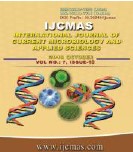


 National Academy of Agricultural Sciences (NAAS)
National Academy of Agricultural Sciences (NAAS)

|
PRINT ISSN : 2319-7692
Online ISSN : 2319-7706 Issues : 12 per year Publisher : Excellent Publishers Email : editorijcmas@gmail.com / submit@ijcmas.com Editor-in-chief: Dr.M.Prakash Index Copernicus ICV 2018: 95.39 NAAS RATING 2020: 5.38 |
A field study from 2009 to 2013 was carried out to investigate the effect of organic manure including panchagavya and biodynamic spray on commonly used tomato-coriander-pea and cauliflower-cauliflower-peacropping system in Western Himalaya. The results revealed that cropping systems differ significantly in terms of soil microbial properties. The tomato-coriander-pea crop sequence recorded higher soil carbon biomass and population of soil bacteria, fungi and actinomycetes as compared to cauliflower-cauliflower-pea crop sequence. The tomato-coriander-pea had enhanced activity of phosphatase enzyme in soil. Soil pH and availability of micronutrients was not influenced under cropping systems, however, organic carbon and availability of major nutrients was significantly improved in tomato-coriander-pea sequence than cauliflower-cauliflower-pea. The highest productivity and net returns were observed for tomato-coriander-pea as compared to cauliflower-cauliflower-pea sequence. Different nutrient sources significantly influenced measured soil and plant parameters except soil pH. The maximum increase in organic carbon, soil carbon biomass, bacteria, fungi, actinomycetes and phosphatase enzyme, availability of major and micronutrients, yield and net returns were observed with farmyard manure application followed by biodynamic and panchagavaya spray as compared to control.
 |
 |
 |
 |
 |